Effect of Pressure Perturbations on CO2 Degassing in a Mofette System: The Case of Hartoušov, Czech Republic
Abstract
:1. Introduction
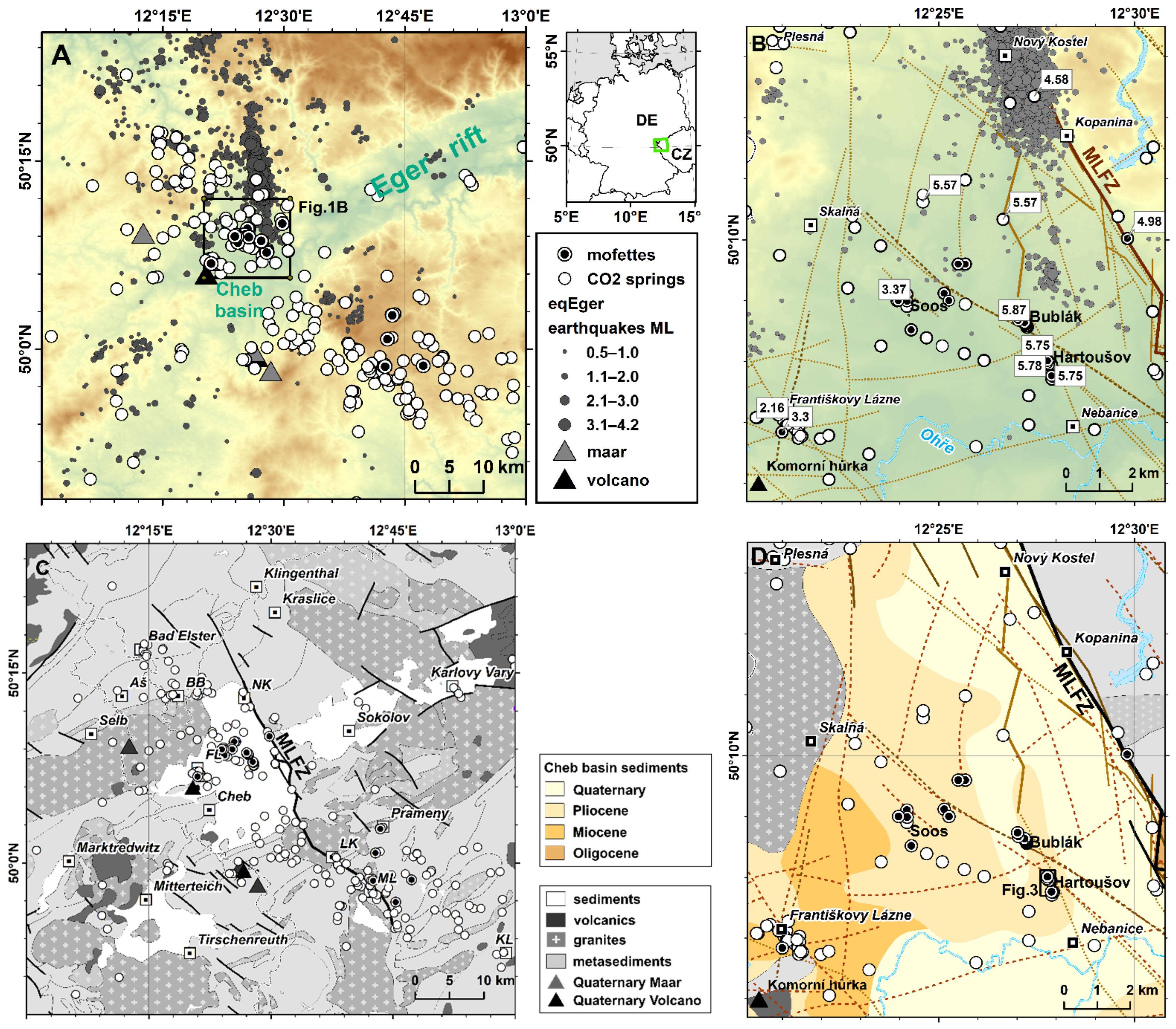
2. Methods and Fluid Monitoring Setup
3. Hydrogeology of Hartoušov Mofette and Cheb Basin
3.1. Geophysical Investigations
3.2. Hydrogeologic and Isotopic Inventory
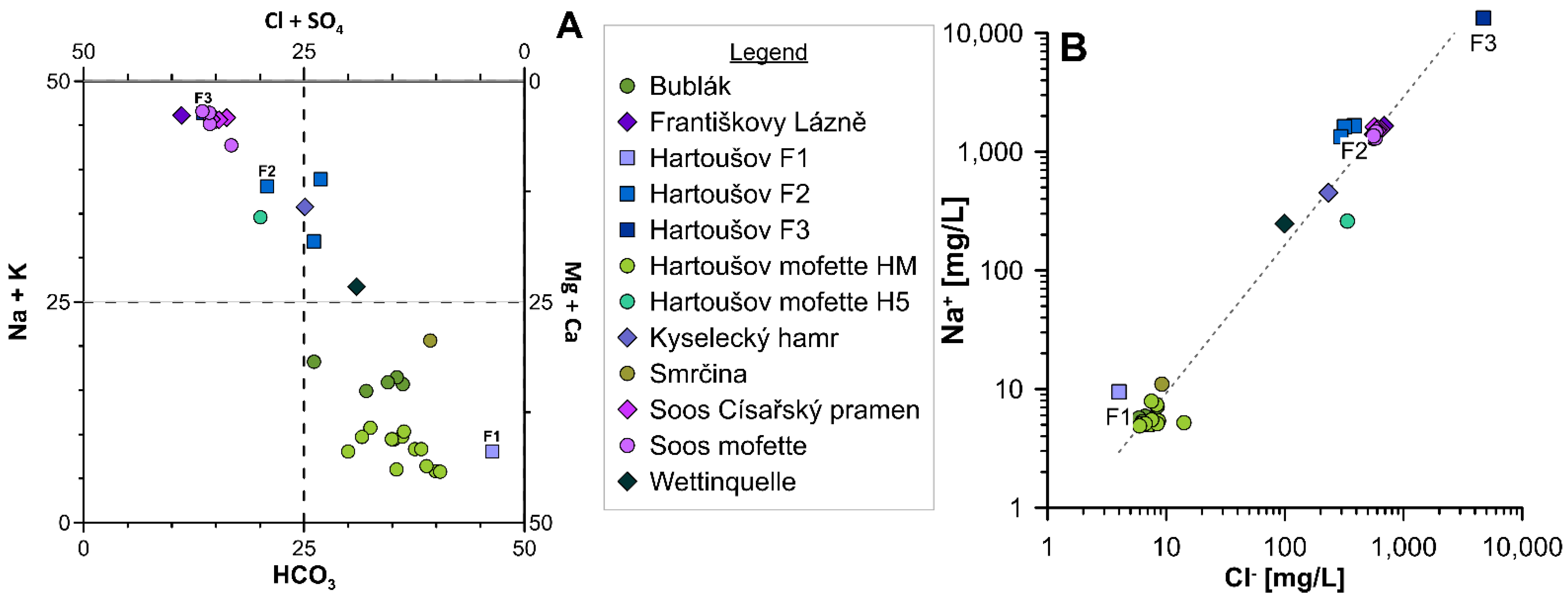
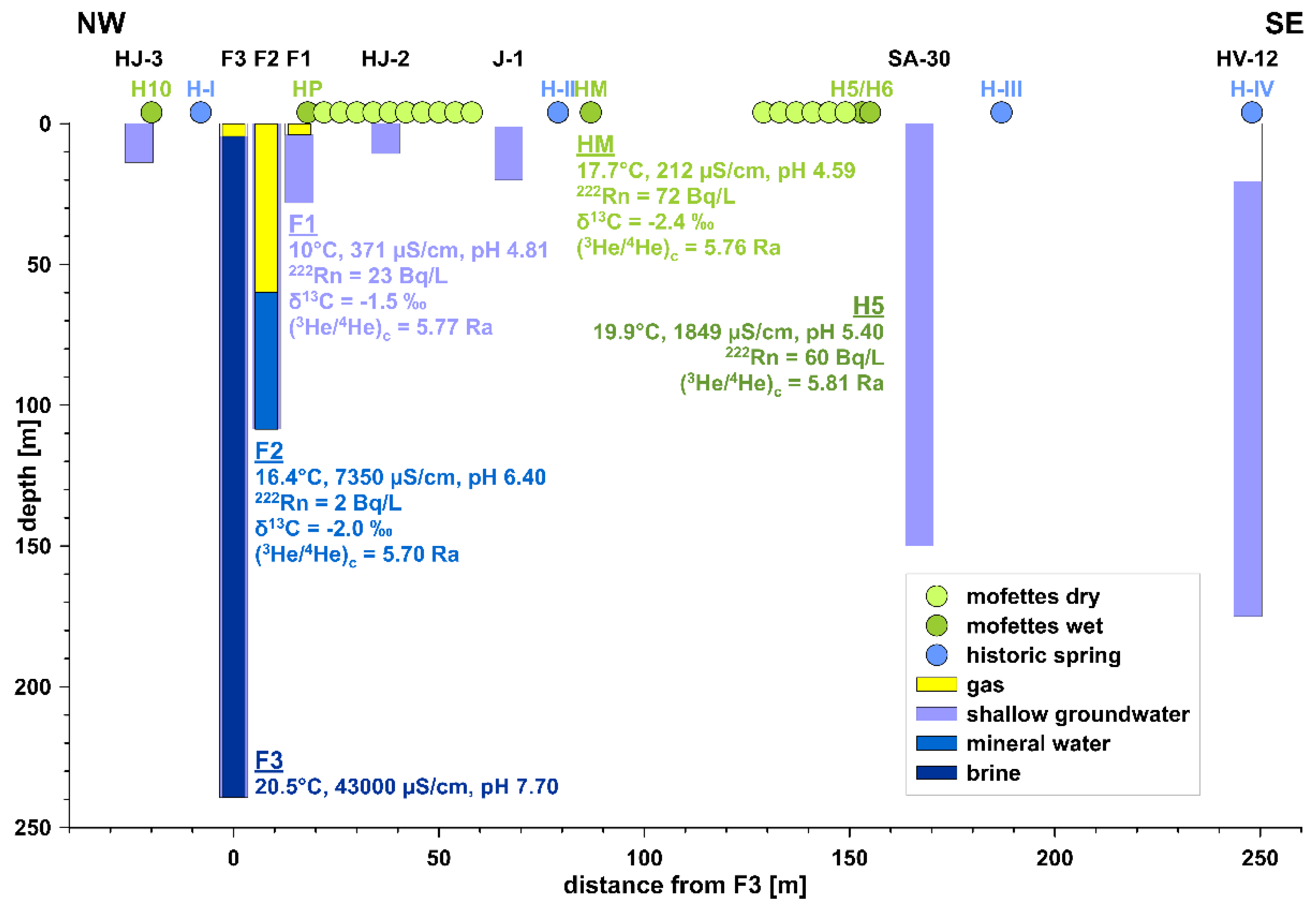
4. Effect of Natural Pressure Perturbations on CO2 Degassing
4.1. Rain-Induced Pressure Transients
4.2. Earthquake-Induced Gas Flow Transients
5. Pressure Transients Related to Stimulation Measures of Well F3
5.1. Pressure Variations after Perforations
5.2. Pressure Recovery in a Closed Hole following Draw-down Tests
5.3. Water Level Recovery in the Open Well following Airlift Operations
6. Pressure Transients Related to Drilling Operations
6.1. Response of F1 and F2 while Drilling F3
6.2. Pressure Drops and Recovery after Drilling F2
7. Tentative Hydro-Mechanical Model
8. Conclusions
- -
- Fluids in the Cheb basin are mixtures between shallow groundwater and brine located at the deepest parts (>230 m below surface) of the segmented basin fillings.
- -
- Deepwater components were also found in two wet mofettes (Hartoušov H5 and Soos), which are usually defined as sites where CO2 degasses through surface water (puddles, ponds, rivers, lakes).
- -
- Over-pressured CO2-rich mineral waters are trapped below the mudstones and clays of the sealing Cypris formation. Drilling through the sealing layer led to several blow-outs in different compartments of the basin.
- -
- External (rain) and internal (earthquakes) events can cause pressure and gas flowrate transients in the fluid system within hours or several days, lasting from days to years.
- -
- The transmissivity at F3 (235 m, T = 5–9 × 10−8 m2/s) is about two orders of magnitude lower than at F2 (108 m, T = 8 × 10−6 m2/s). This has implications for the response time to pressure transients at different depth levels of the mofette system.
- -
- Pressure oscillations at a wellhead are described for the first time as a potentially natural analog to a two-phase pipe–relief valve system known from industrial applications.
Author Contributions
Funding
Data Availability Statement
Acknowledgments
Conflicts of Interest
Appendix A
| Hartoušov | Hartoušov | Hartoušov | Hartoušov | Hartoušov | Františkovy | Soos | |||
|---|---|---|---|---|---|---|---|---|---|
| Mofette | Mofette | Well | Well | Well | Lázně | Kyselecký | Císařský | ||
| HM | H5 | F1 | F2 * | F3 * | E-1 Erika * | Hamr | Pramen | ||
| sample DATE | 03.09.2019 | 29.08.2019 | 03.09.2019 | 23.05.2016 | 10.09.2020 | 29.07.2020 | 18.06.2019 | 19.06.2019 | |
| water temp. (°C) | 17.7 | 19.9 | 10.0 | 18.4 | 20.5 | 13.9 | 8.6 | 17.3 | |
| spec.elec.cond. (µS/cm) | 212 | 1849 | 371 | 6730 | 43,000 | 6790 | 2620 | 6630 | |
| pH | 4.59 | 5.40 | 4.81 | 6.67 | 7.70 | 5.90 | 6.03 | 6.05 | |
| mmol(eq) % | Ca2+ | 49.5 | 20.1 | 52.5 | 15.7 | 2.0 | 5.3 | 9.8 | 4.1 |
| Mg2+ | 15.5 | 3.7 | 20.6 | 7.6 | 5.3 | 2.0 | 18.7 | 2.5 | |
| Na+ | 11.6 | 67.0 | 10.4 | 74.6 | 91.0 | 91.2 | 67.8 | 90.2 | |
| K+ | 7.9 | 2.1 | 5.8 | 1.6 | 1.8 | 1.0 | 3.7 | 1.5 | |
| Cl− | 12.2 | 52.8 | 3.1 | 10.3 | 21.2 | 25.5 | 22.4 | 20.8 | |
| SO42− | 15.4 | 7.1 | 4.1 | 48.1 | 51.7 | 52.3 | 27.4 | 46.8 | |
| HCO3− | 72.2 | 40.1 | 92.7 | 41.6 | 27.1 | 22.2 | 50.2 | 32.4 | |
| % | ionic balance | −0.48 | −3.10 | 4.53 | −4.80 | 1.18 | 2.34 | −0.43 | 0.55 |
| saturation index | Calcite | −3.68 | −1.77 | −2.90 | 0.49 | 1.64 | −1.25 | −1.19 | −1.00 |
| Dolomite | −7.83 | −4.21 | −6.30 | 0.69 | 3.78 | −2.94 | −2.22 | −2.18 | |
| Halite | −8.89 | −5.66 | −8.96 | −4.92 | −3.06 | −4.64 | −5.60 | −4.74 | |
| Gypsum | −2.81 | −1.94 | −2.84 | −0.32 | −0.29 | −0.84 | −1.36 | −1.01 | |
| Anhydrite | −3.19 | −2.30 | −3.31 | −0.69 | −0.63 | −1.27 | −1.86 | −1.39 | |
| Chalcedony | 0.23 | 0.40 | 0.91 | 0.80 | 0.67 | 0.73 | 0.74 | 0.86 | |
| Quartz | 0.69 | 0.84 | 1.39 | 1.25 | 1.11 | 1.19 | 1.22 | 1.31 | |
| CO2(g) | 0.31 | 0.17 | 0.42 | −0.38 | −0.91 | −0.04 | −0.22 | 0.01 | |
| pCO2 (kPa) | 204 | 149 | 260 | 42 | 12 | 92 | 61 | 101 | |
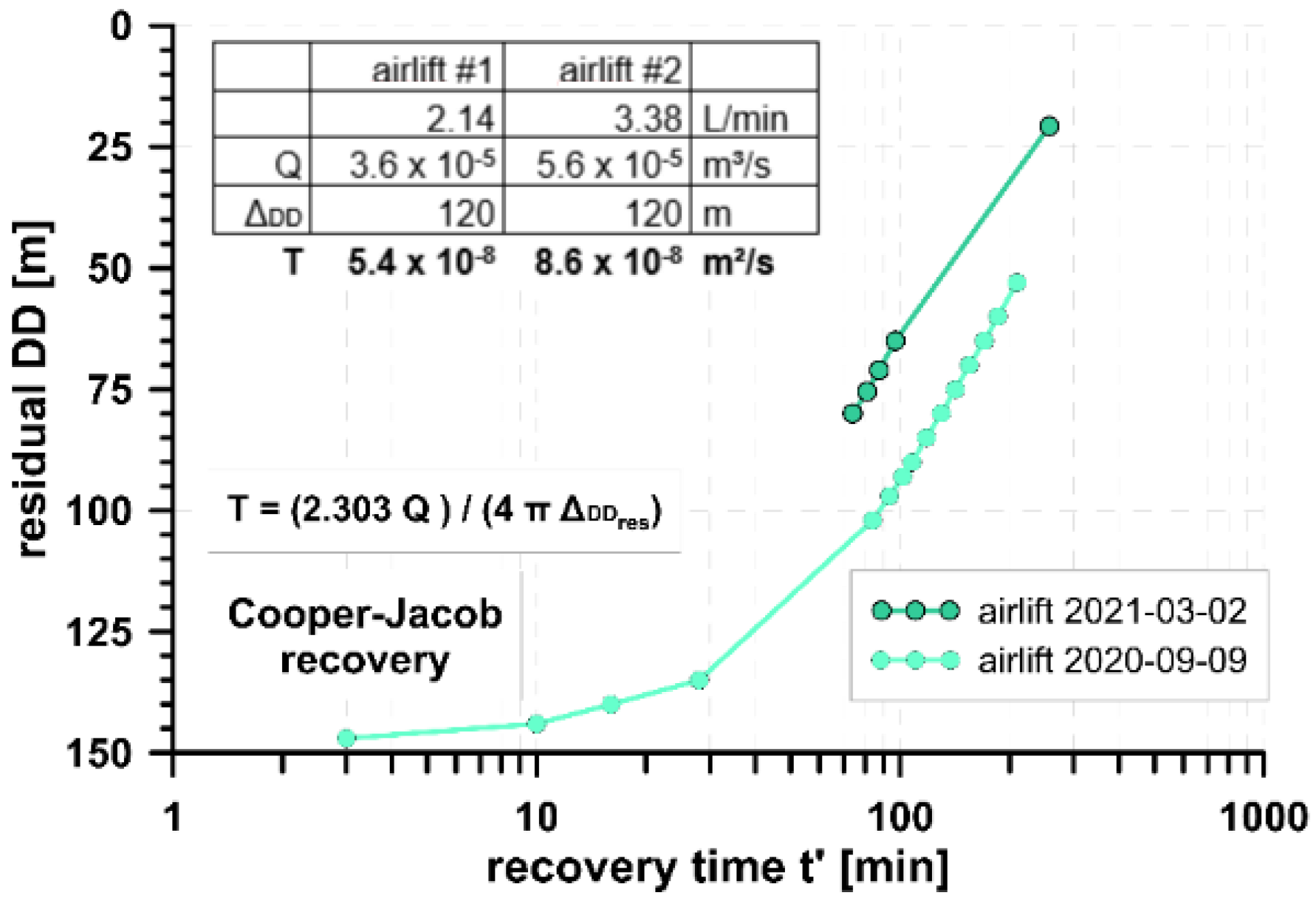
References
- Mörner, N.A.; Etiope, G. Carbon Degassing from the Lithosphere. Glob. Planet. Change 2002, 33, 185–203. [Google Scholar] [CrossRef]
- Chiodini, G.; Granieri, D.; Avino, R.; Caliro, S.; Costa, A.; Minopoli, C.; Vilardo, G. Non-Volcanic CO2 Earth Degassing: Case of Mefite D’ansanto (Southern Apennines), Italy. Geophys. Res. Lett. 2010, 37, L11303. [Google Scholar] [CrossRef]
- Karin, B.; Kämpf, H.; Strauch, G. Seismically Triggered Anomalies in the Isotope Signatures of Mantle-Derived Gases Detected at Degassing Sites Along Two Neighboring Faults in Nw Bohemia, Central Europe. J. Geophys. Res.-Solid Earth 2014, 119, 5613–5632. [Google Scholar] [CrossRef] [Green Version]
- Etiope, G.; Martinelli, G. Migration of Carrier and Trace Gases in the Geosphere: An Overview. Phys. Earth Planet. Inter. 2002, 129, 185–204. [Google Scholar] [CrossRef]
- Weinlich, F.H.; Stejskal, V.; Teschner, M.; Poggenburg, J. Geodynamic Processes in the Nw Bohemian Swarm Earthquake Region, Czech Republic, Identified by Continuous Gas Monitoring. Geofluids 2013, 13, 305–330. [Google Scholar] [CrossRef]
- Dahm, T.; Hrubcová, P.; Fischer, T.; Horálek, J.; Korn, M.; Buske, S.; Wagner, D. Eger Rift Icdp: An Observatory for Study of Non-Volcanic, Mid-Crustal Earthquake Swarms and Accompanying Phenomena. Sci. Drill. 2013, 16, 93–99. [Google Scholar] [CrossRef] [Green Version]
- Fischer, T.; Hrubcová, P.; Dahm, T.; Woith, H.; Vylita, T.; Ohrnberger, M.; Vlček, J.; Horálek, J.; Dědeček, P.; Zimmer, M.; et al. Icdp Drilling of the Eger Rift Observatory: Magmatic Fluids Driving the Earthquake Swarms and Deep Biosphere. Sci. Drill. 2022, 31, 31–49. [Google Scholar] [CrossRef]
- IPCC. Ipcc Special Report on Carbon Dioxide Capture and Storage. In Working Group Iii of the Intergovernmental Panel on Climate Change; Davidson, O., Metz, B., de Coninck, H.C., Loos, M., Meyer, L.A., Eds.; Cambridge University Press: Cambridge, UK, 2005. [Google Scholar]
- Schütze, C.; Sauer, U.; Beyer, K.; Lamert, H.; Bräuer, K.; Strauch, G.; Flechsig, C.; Kämpf, H.; Dietrich, P. Natural Analogues: A Potential Approach for Developing Reliable Monitoring Methods to Understand Subsurface CO2 Migration Processes. Environ. Earth Sci. 2012, 67, 411–423. [Google Scholar] [CrossRef]
- Jia, B.; Chen, Z.L.; Xian, C.G. Investigations of CO2 Storage Capacity and Flow Behavior in Shale Formation. J. Pet. Sci. Eng. 2022, 208, 109659. [Google Scholar] [CrossRef]
- Flohr, A.; Schaap, A.; Achterberg, E.P.; Alendal, G.; Arundell, M.; Berndt, C.; Blackford, J.; Böttner, C.; Borisov, S.M.; Brown, R.; et al. Towards Improved Monitoring of Offshore Carbon Storage: A Real-World Field Experiment Detecting a Controlled Sub-Seafloor CO2 Release. Int. J. Greenh. Gas Control 2021, 106, 103237. [Google Scholar] [CrossRef]
- Kämpf, H.; Bräuer, K.; Schumann, J.; Hahne, K.; Strauch, G. CO2 Discharge in an Active, Non-Volcanic Continental Rift Area (Czech Republic): Characterisation (δ13C, 3He/4He) and Quantification of Diffuse and Vent CO2 Emissions. Chem. Geol. 2013, 339, 71–83. [Google Scholar] [CrossRef]
- Pfanz, H. Mofetten: Kalter Atem Schlafender Vulkane; Deutsche Vulkanologische Gesellschaft: Mendig, Germany, 2008. [Google Scholar]
- Bräuer, K.; Kämpf, H.; Strauch, G.; Weise, S.M. Isotopic Evidence (3He/4He, 13CCO2) of Fluid-Triggered Intraplate Seismicity. J. Geophys. Res. B Solid Earth Planets 2003, 108, 2070. [Google Scholar] [CrossRef]
- Horalek, J.; Fischer, T. Role of Crustal Fluids in Triggering the West Bohemia/Vogtland Earthquake Swarms: Just What We Know (a Review). Stud. Geophys. Et Geod. 2008, 52, 455–478. [Google Scholar] [CrossRef]
- Peterek, A.; Retuher, C.D.; Schunk, R. Neotectonic Evolution of the Cheb Basin (Northwestern Bohemia, Czech Republic) and Its Implication for the Late Pliocene to Recent Deformation in the Western Part of the Eger Rift. Z. Geol. Wiss. Berl. 2011, 5, 335–365. [Google Scholar]
- Heinicke, J.; Woith, H. Mofettes and CO2-Rich Mineral Waters of the Nw Bohemia-Vogtland Region; GFZ Data Services: Potsdam, Germany, 2022. [Google Scholar] [CrossRef]
- Weinlich, F.H.; Bräuer, K.; Kämpf, H.; Strauch, G.; Tesař, J.; Weise, S.M. An Active Subcontinental Mantle Volatile System in the Western Eger Rift, Central Europe: Gas Flux, Isotopic (He, C, and N) and Compositional Fingerprints. Geochim. Et Cosmochim. Acta 1999, 63, 3653–3671. [Google Scholar] [CrossRef]
- Nickschick, T.; Kämpf, H.; Flechsig, C.; Mrlina, J.; Heinicke, J. CO2 Degassing in the Hartoušov Mofette Area, Western Eger Rift, Imaged by CO2 Mapping and Geoelectrical and Gravity Surveys. Int. J. Earth Sci. 2015, 104, 2107–2129. [Google Scholar] [CrossRef]
- Kämpf, H.; Broge, A.S.; Marzban, P.; Allahbakhshi, M.; Nickschick, T. Nonvolcanic Carbon Dioxide Emission at Continental Rifts: The Bublak Mofette Area, Western Eger Rift, Czech Republic. Geofluids 2019, 2019, 4852706. [Google Scholar] [CrossRef]
- Bräuer, K.; Kämpf, H.; Niedermann, S.; Strauch, G. Monitoring of Helium and Carbon Isotopes in the Western Eger Rift Area (Czech Republic): Relationships with the 2014 Seismic Activity and Indications for Recent (2000–2016) Magmatic Unrest. Chem. Geol. 2018, 482, 131–145. [Google Scholar] [CrossRef]
- Daskalopoulou, K.; Woith, H.; Zimmer, M.; Niedermann, S.; Barth, J.A.C.; Frank, A.H.; Vieth-Hillebrand, A.; Vlček, J.; Bağ, C.D.; Bauz, R. Insight into Hartoušov Mofette, Czech Republic: Tales by the Fluids. Front. Earth Sci. 2021, 9, 615766. [Google Scholar] [CrossRef]
- Fischer, T.; Vlček, J.; Lanzendörfer, M. Monitoring Crustal CO2 Flow: Methods and Their Applications to the Mofettes in West Bohemia. Solid Earth 2020, 11, 983–998. [Google Scholar] [CrossRef]
- Woith, H.; Daskalopoulou, K.; Zimmer, M.; Fischer, T.; Vlček, J.; Trubač, J.; Rosberg, J.E.; Vylita, T.; Dahm, T. Multi-Level Gas Monitoring: A New Approach in Earthquake Research. Front. Earth Sci. 2020, 8, 585733. [Google Scholar] [CrossRef]
- Woith, H. Spatial and Temporal Variations of Radon in Ground Air and Ground Water within the Mudurnu Valley, Nw-Turkey. A Contribution to the Turkish-German Joint Project on Earthquake Research. Ph.D. Thesis, Christian-Albrechts-University Kiel, Kiel, Germany, 1996. [Google Scholar]
- Parkhurst, D.L.; Appelo, C.A.J. User’s Guide to Phreeqc (Version 2), 312; US Geological Survey: Denver, Colorado, 1999.
- Flechsig, C.; Bussert, R.; Rechner, J.; Schütze, C.; Kämpf, H. The Hartousov Mofette Field in the Cheb Basin, Western Eger Rift (Czech Republic): A Comperative Geoelectric, Sedimentologic and Soil Gas Study of a Magmatic Diffuse CO2-Degassing Structure. Z. Für Geol. Wiss. 2008, 36, 177–193. [Google Scholar]
- Sandig, C.; Sauer, U.; Bräuer, K.; Serfling, U.; Schutze, C. Comparative Study of Geophysical and Soil-Gas Investigations at the Hartousov (Czech Republic) Natural CO2 Degassing Site. Environ. Earth Sci. 2014, 72, 1421–1434. [Google Scholar] [CrossRef]
- Bussert, R.; Kämpf, H.; Flechsig, C.; Hesse, K.; Nickschick, T.; Liu, Q.; Umlauft, J.; Vylita, T.; Wagner, D.; Wonik, T.; et al. Drilling into an Active Mofette: Pilot-Hole Study of the Impact of CO2-Rich Mantle-Derived Fluids on the Geo–Bio Interaction in the Western Eger Rift (Czech Republic). Sci. Dril. 2017, 23, 13–27. [Google Scholar] [CrossRef] [Green Version]
- Umlauft, J.; Korn, M. 3-D Fluid Channel Location from Noise Tremors Using Matched Field Processing. Geophys. J. Int. 2019, 219, 1550–1561. [Google Scholar] [CrossRef]
- Flores Estrella, H.; Umlauft, J.; Schmidt, A.; Korn, M. Locating Mofettes Using Seismic Noise Records from Small Dense Arrays and Matched Field Processing Analysis in the NW Bohemia/Vogtland Region, Czech Republic. Near Surf. Geophys. 2016, 14, 327–335. [Google Scholar] [CrossRef]
- Langelier, W.; Ludwig, H. Graphical Methods for Indicating the Mineral Character of Natural Waters. J. Am. Water Assoc. 1942, 34, 335–352. [Google Scholar] [CrossRef]
- Fiala, J.; Vejnar, Z. The Lithology, Geochemistry, and Metamorphic Gradation of the Crystalline Basement of the Cheb (Eger) Tertiary Basin, Saxothuringian Unit. Bull. Geosci. 2004, 79, 41–52. [Google Scholar]
- Fischer, T.; Matyska, C.; Heinicke, J. Earthquake-Enhanced Permeability—Evidence from Carbon Dioxide Release Following the ML 3.5 Earthquake in West Bohemia. Earth Planet. Sci. Lett. 2017, 460, 60–67. [Google Scholar] [CrossRef]
- Sibson, R.H. Fault-Valve Behavior and the Hydrostatic-Lithostatic Fluid Pressure Interface. In Metamorphic Fluids; Fyfe, W.S., Ed.; Elsevier: Amsterdam, The Netherlands, 1992; pp. 141–144. [Google Scholar]
- Zeileis, A.; Kleiber, C.; Kramer, W.; Hornik, K. Testing and Dating of Structural Changes in Practice. Comput. Stat. Data Anal. 2003, 44, 109–123. [Google Scholar] [CrossRef] [Green Version]
- Wang, C.Y.; Manga, M. Earthquakes and Water. In Lecture Notes in Earth Sciences; Springer: Berlin/Heidelberg, Germany, 2010; Volume 114. [Google Scholar]
- Roeloffs, E.A. Persistent Water Level Changes in a Well near Parkfield, California, Due to Local and Distant Earthquakes. J. Geophys. Res. 1998, 103, 869–889. [Google Scholar] [CrossRef]
- Steinberg, G.S.; Steinberg, A.S.; Merzhanov, A.G. Fluid Mechanism of Pressure Rise in Volcanic (Magmatic) Systems with Mass Exchange. Mod. Geol. 1989, 13, 275–281. [Google Scholar]
- Woith, H.; Wang, R.J.; Milkereit, C.; Zschau, J.; Maiwald, U.; Pekdeger, A. Heterogeneous Response of Hydrogeological Systems to the Izmit and Duzce (Turkey) Earthquakes of 1999. Hydrogeol. J. 2003, 11, 113–121. [Google Scholar] [CrossRef]
- Wang, R.; Woith, H.; Milkereit, C.; Zschau, J. Modelling of Hydrogeochemical Anomalies Induced by Distant Earthquakes. Geophys. J. Int. 2004, 157, 717–726. [Google Scholar] [CrossRef] [Green Version]
- Bjornstad, B.N.; McKinley, J.P.; Stevens, T.O.; Rawson, S.A.; Frederickson, J.K.; Long, P.E. Generation of Hydrogen Gas as a Result of Drilling within The Saturated Zone. Ground Water Monit. Remediat. 1994, 14, 140–147. [Google Scholar] [CrossRef]
- Daniels, L.; Belay, N.; Rajagopal, B.S.; Weimer, P.J. Bacterial Methanogenesis and Growth from CO2 with Elemental Iron as the Sole Source of Electrons. Science 1987, 237, 509–511. [Google Scholar] [CrossRef]
- Anisichkin, V.F. Mechanism of Carbon Release during Detonation Decomposition of Substances. Combust. Explos. Shock Waves 1994, 30, 667–673. [Google Scholar] [CrossRef]
- Cooper, H.H.; Jacob, C.E. A Generalized Graphical Method for Evaluating Formation Constants and Summarizing Well Field History. Trans. Am. Geophys. Union 1946, 27, 526–534. [Google Scholar] [CrossRef]
- Freeze, A.R.; Cherry, J.A. Groundwater; Prentice Hall: Englewood Cliffs, NJ, USA, 1979. [Google Scholar]
- Wang, C.; Yang, J.; Nilsson, H. Simulation of Water Level Fluctuations in a Hydraulic System Using a Coupled Liquid-Gas Model. Water 2015, 7, 4446–4476. [Google Scholar] [CrossRef] [Green Version]
- Fischer, T.; Horálek, J.; Hrubcová, P.; Vavryčuk, V.; Bräuer, K.; Kämpf, H. Intra-Continental Earthquake Swarms in West-Bohemia and Vogtland: A Review. Tectonophysics 2014, 611, 1–27. [Google Scholar] [CrossRef]
- Kolářová, M. Hydrogeologie chebské pánve. Sb. Geol. Věd Hydrogeol. Inz. Geol. 1965, 3, 7–101. [Google Scholar]
- Hurst, A.; Scott, A.; Vigorito, M. Physical Characteristics of Sand Injectites. Earth-Sci. Rev. 2011, 106, 215–246. [Google Scholar] [CrossRef]
- Pitz, M.; Bussert, R. Proceedings of the CO2-Induced Natural Deformation Structures in Well HJB-1 (Cheb Basin, Czech Republic), Münster, Germany, 22–25 September 2019; Available online: https://www.google.com/url?sa=t&rct=j&q=&esrc=s&source=web&cd=&cad=rja&uact=8&ved=2ahUKEwj76ri53on8AhWBlmoFHXrsAeUQFnoECA4QAQ&url=http%3A%2F%2Fwww.geomuenster2019.de%2Fassets%2Fgeomuenster_book_of_abstracts.pdf&usg=AOvVaw3rosxMXO1ZOpTHYjNxevN9 (accessed on 27 October 2022).
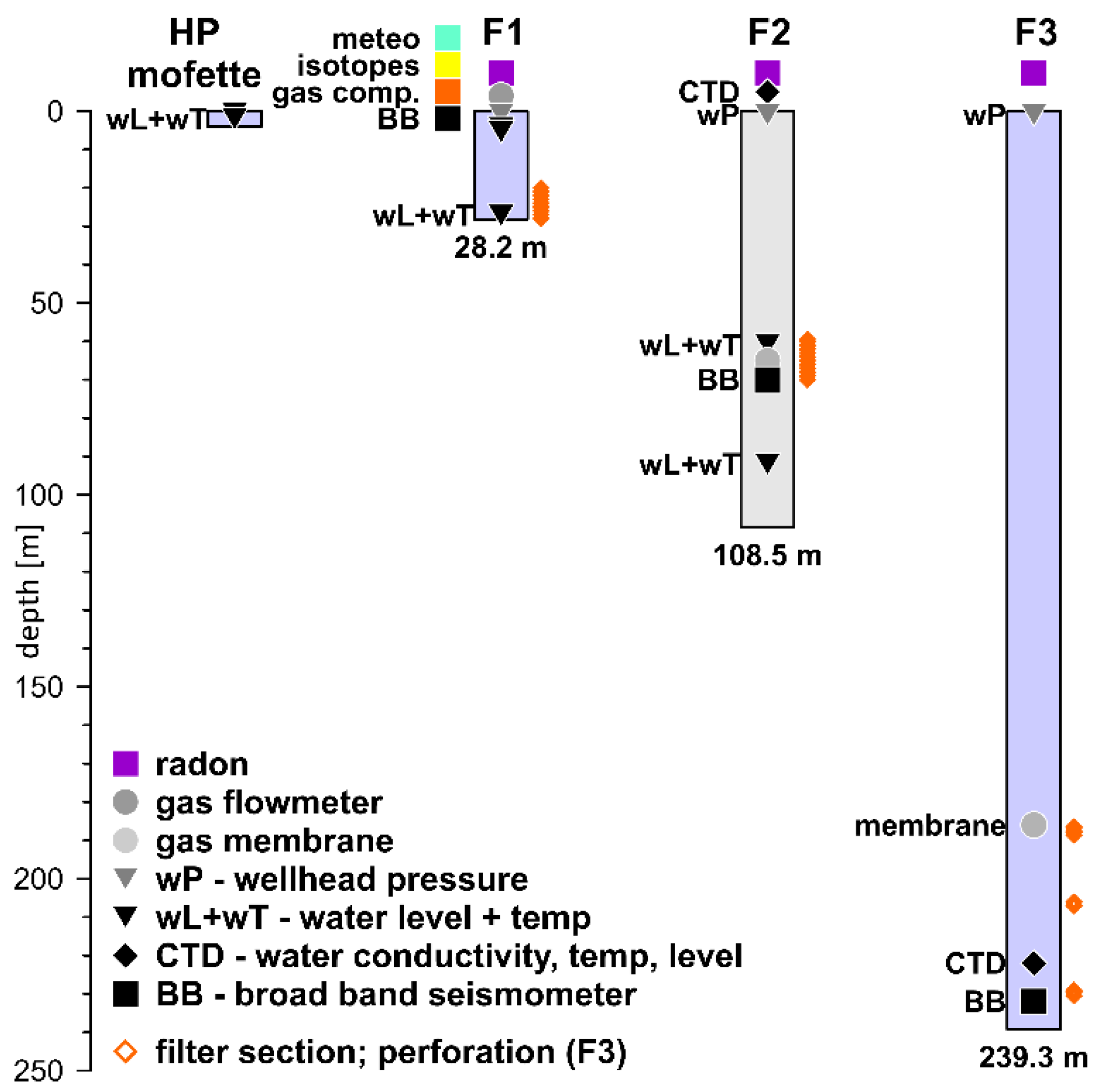
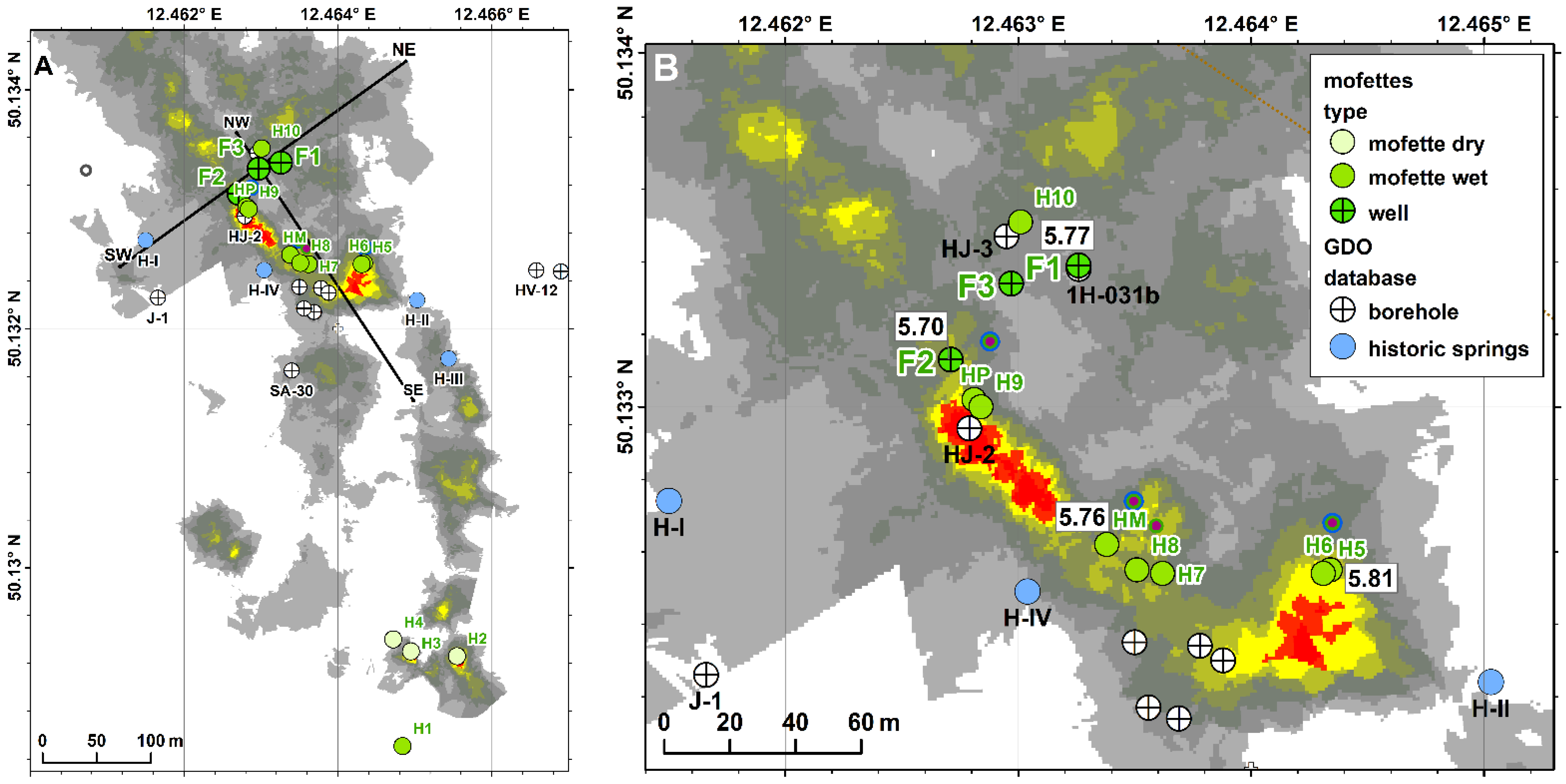
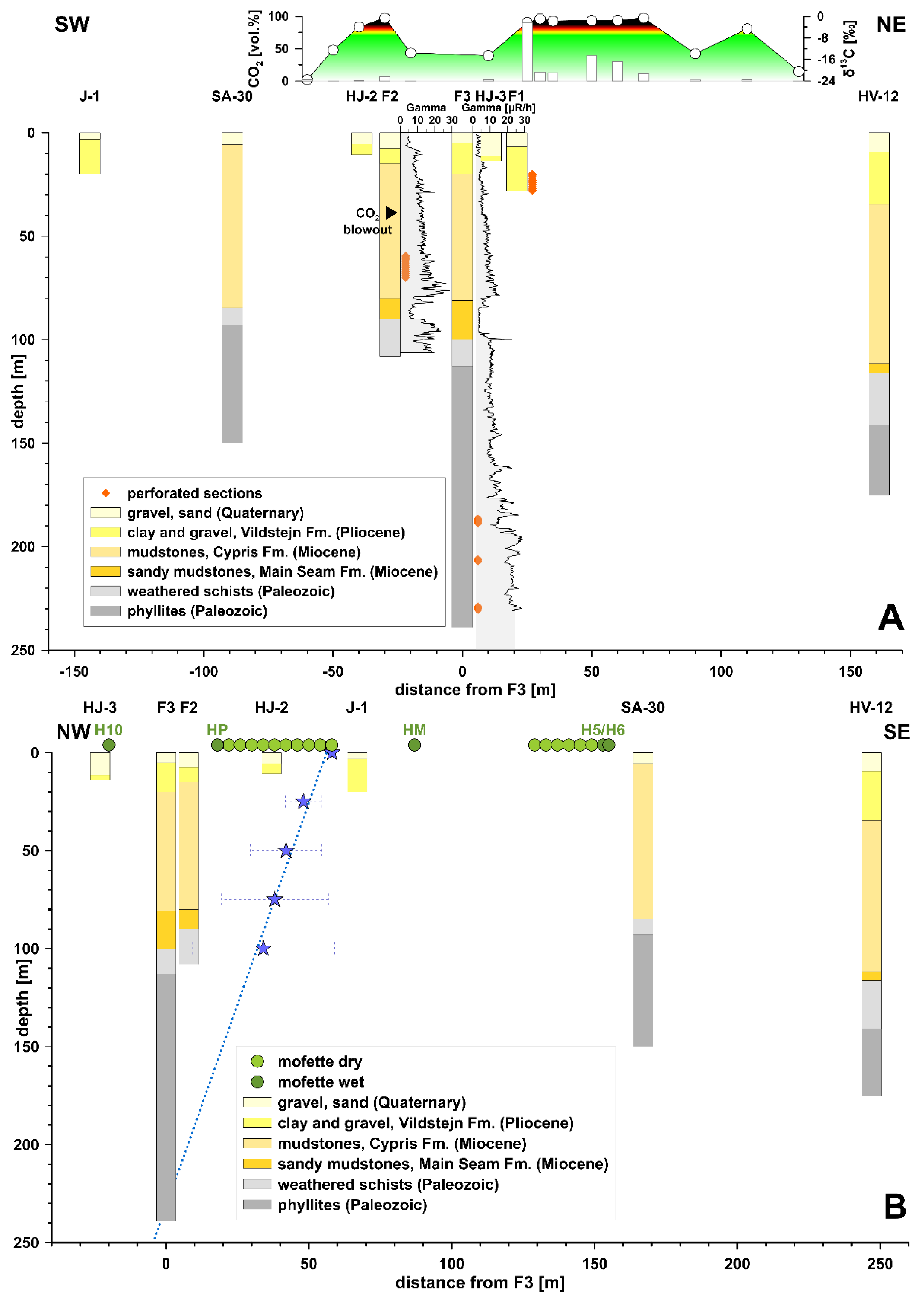
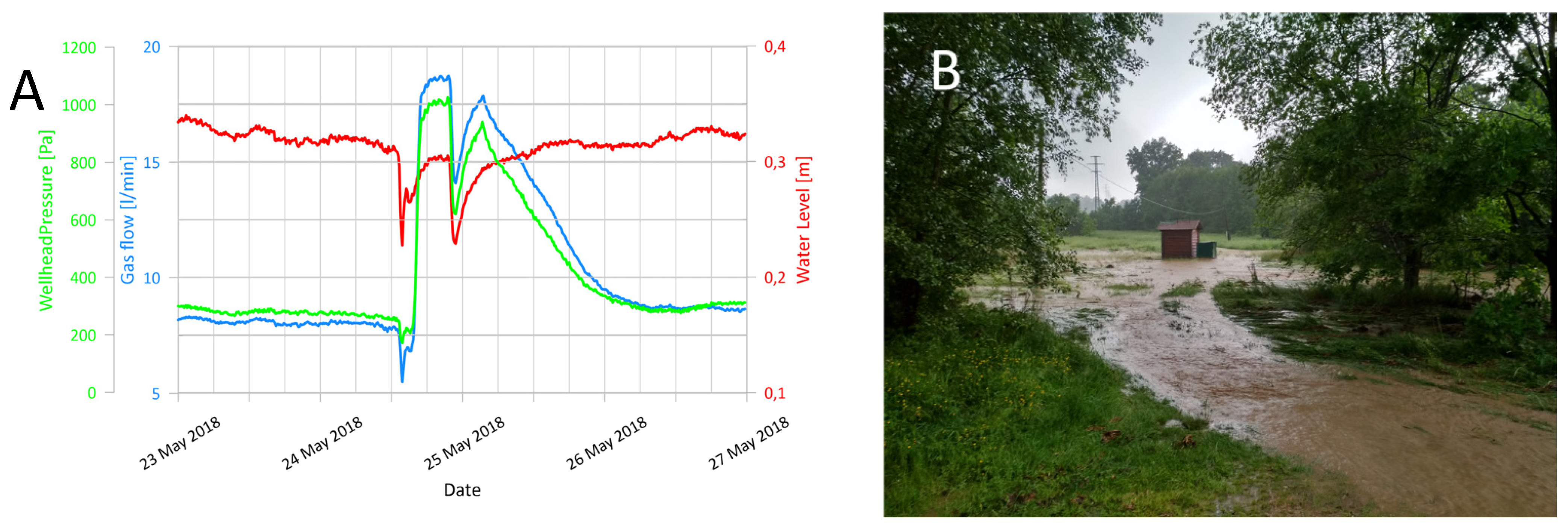
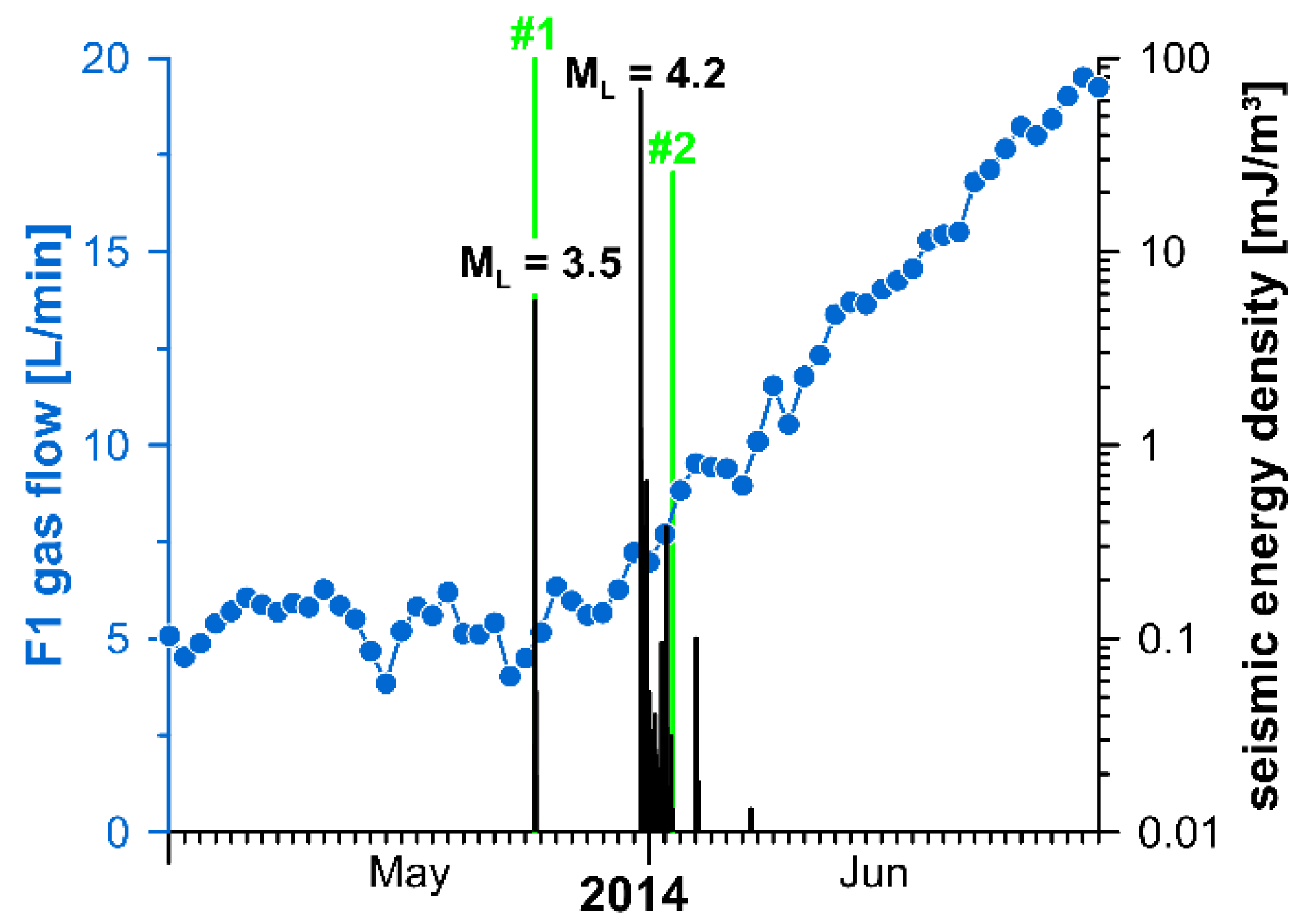
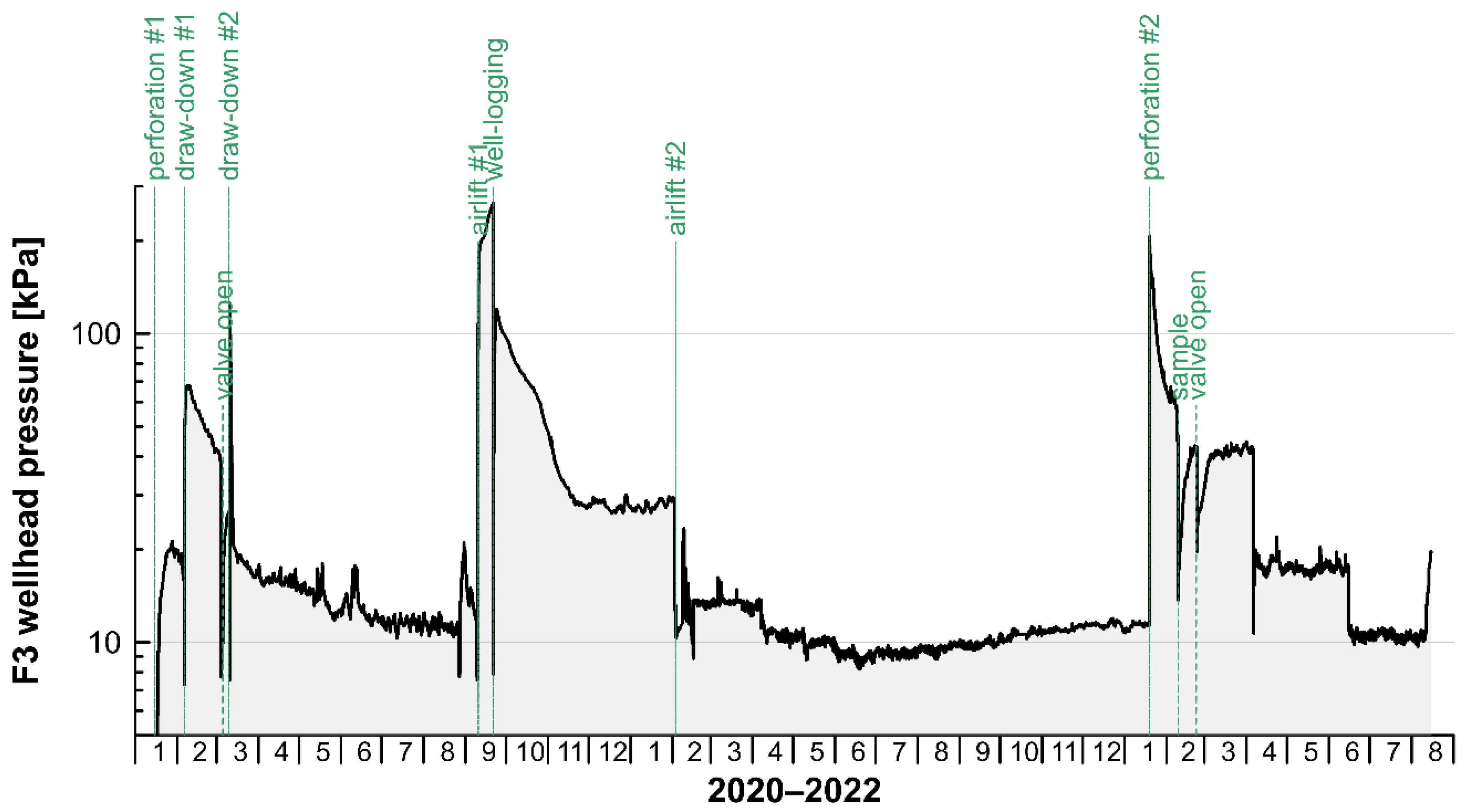
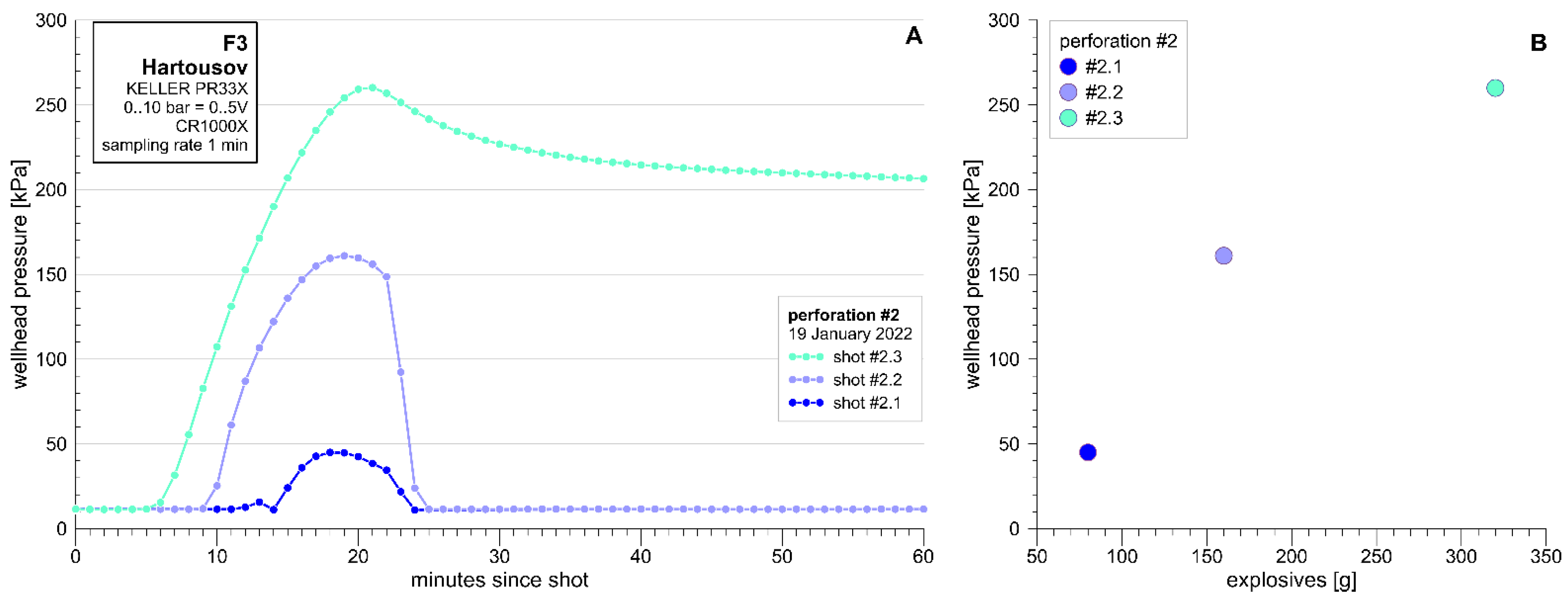
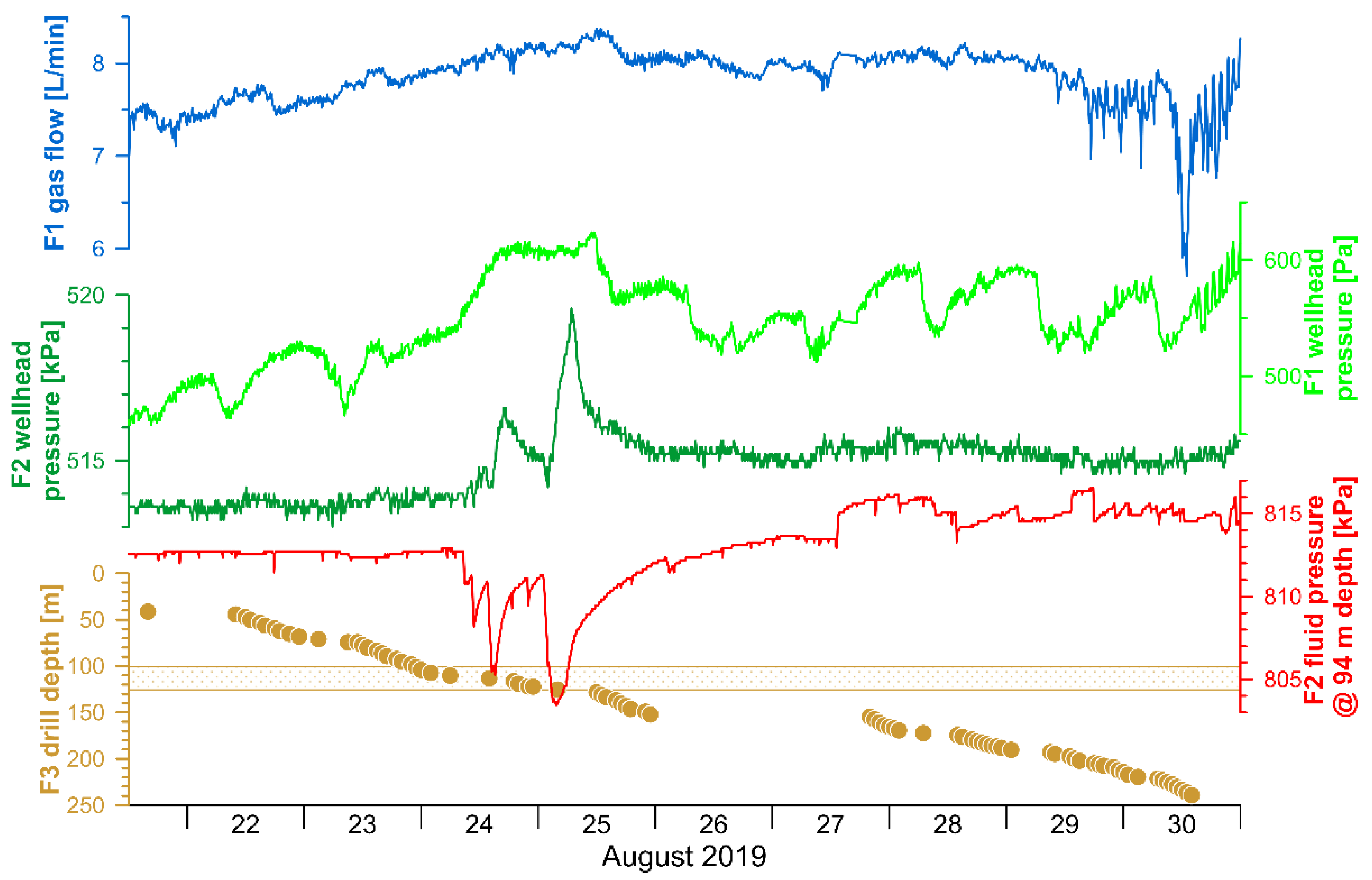
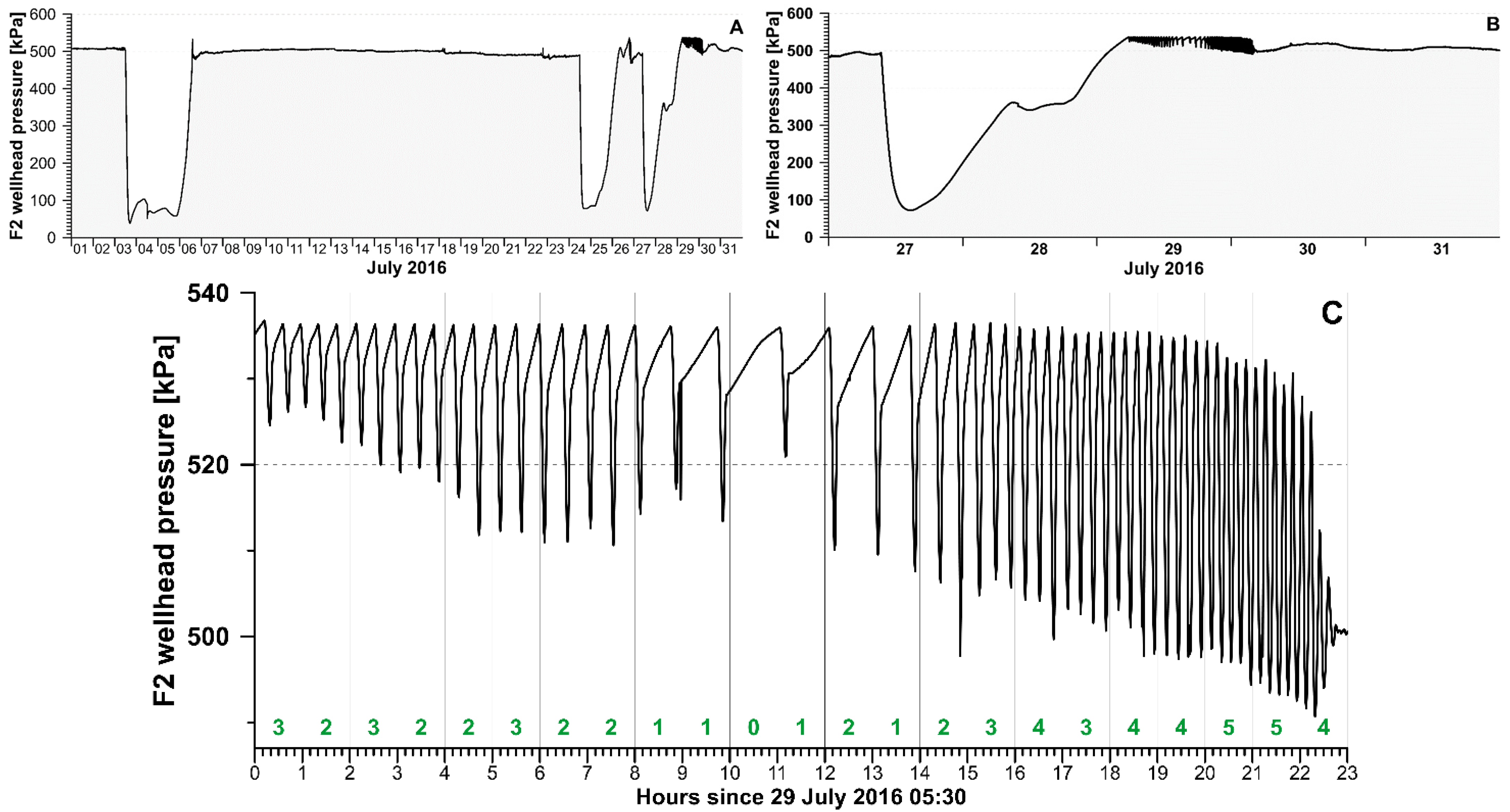
| Hartoušov | Hartoušov | Hartoušov | Hartoušov | Hartoušov | Františkovy | Soos | |||
|---|---|---|---|---|---|---|---|---|---|
| Mofette | Mofette | Well | Well | Well | Lázně | Kyselecký | Císařský | ||
| HM | H5 | F1 | F2 * | F3 * | E-1 Erika * | Hamr | Pramen | ||
| sample DATE | 03.09.2019 | 29.08.2019 | 03.09.2019 | 23.05.2016 | 10.09.2020 | 29.07.2020 | 18.06.2019 | 19.06.2019 | |
| water temp. (°C) | 17.7 | 19.9 | 10.0 | 18.4 | 20.5 | 13.9 | 8.6 | 17.3 | |
| spec.elec.cond. (µS/cm) | 212 | 1849 | 371 | 6730 | 43,000 | 6790 | 2620 | 6630 | |
| pH | 4.59 | 5.40 | 4.81 | 6.67 | 7.70 | 5.90 | 6.03 | 6.05 | |
| mg/L | Li+ | n.a. | n.a. | 0.20 | 2.70 | n.a. | 2.57 | 1.90 | 3.30 |
| Na+ | 5.1 | 260 | 9.5 | 1660 | 13,400 | 1650 | 453 | 1614 | |
| K+ | 5.9 | 14 | 9 | 60 | 449 | 31.7 | 42 | 46 | |
| Mg2+ | 3.6 | 7.6 | 10 | 89 | 411 | 19.4 | 66 | 24 | |
| Ca2+ | 19 | 68 | 42 | 305 | 252 | 84 | 57 | 64 | |
| Sr2+ | n.a. | 0.23 | 0.30 | 6.40 | n.a. | 0.69 | 0.36 | 0.10 | |
| Ba2+ | 0.07 | 0.08 | 0.14 | 0.03 | n.a. | 0.01 | b.d.l. | b.d.l. | |
| Mn2+ | 0.18 | 0.70 | 0.51 | n.a. | n.a. | 0.53 | 0.24 | 1.60 | |
| Fe2+/3+ | 8.3 | 33.0 | 12.0 | 13.7 | 2.7 | 8.9 | n.a. | 35 | |
| SiO2 | 23.6 | 36.4 | 89.9 | 86.2 | 57.2 | 64.3 | 57.8 | 96.4 | |
| F− | 0.08 | 0.11 | 0.51 | 0.60 | n.a. | 0.81 | b.d.l. | b.d.l. | |
| Cl− | 8.4 | 336 | 4 | 384 | 4710 | 682 | 233 | 569 | |
| SO42− | 14.3 | 61 | 7.2 | 2430 | 15,600 | 1890 | 386 | 1731 | |
| HCO3− | 85 | 439 | 207 | 2670 | 10,400 | 1020 | 897 | 1525 | |
| 222Rn gas (Bq/L) | 71.7 | 59.6 | 22.7 | 2 x | n.a. | n.a. | 0.1 | 304 | |
| δ13C (‰) | −2.4 | n.a. | −1.5 | −1.8 § | n.a. | n.a. | n.a. | n.a. | |
| (3He/4He)c (RA) | 5.76 ± 0.09 § | 5.81 ± 0.30 | 5.77 ± 0.09 $ | 5.70 ± 0.10 § | n.a. | n.a. | 3.86 ± 0.09 | 3.24 ± 0.08 | |
| 4He/20Ne | 22.7 ± 1.6 § | 72.5 ± 6.3 | 203 ± 18 $ | 18.7 ± 1.3 § | n.a. | n.a. | 8.38 ± 0.49 | 14.9 ± 1.1 | |
| vol.% | CO2 | 99.85 | 99.87 | 99.75 | 99.87 | n.a. | n.a. | 99.67 | 99.88 |
| O2 | 0.02 | 0.01 | 0.05 | 0.02 | n.a. | n.a. | 0.10 | 0.04 | |
| N2 | 0.12 | 0.11 | 0.20 | 0.11 | n.a. | n.a. | 0.22 | 0.08 | |
| µmol/mol | He | 20.3 | 23.5 | 25.8 | 24.9 | n.a. | n.a. | 0.5 | 0.2 |
| H2 | b.d.l. | 0.8 | b.d.l. | b.d.l. | n.a. | n.a. | b.d.l. | b.d.l. | |
| Ar | 28.1 | 28.1 | 43.9 | 23.8 | n.a. | n.a. | 56.7 | 18.2 | |
| CH4 | 5.53 | 15.7 | 4.95 | 5.99 | n.a. | n.a. | 2.32 | 2.68 | |
| C2H4 | b.d.l. | 0.01 | b.d.l. | b.d.l. | n.a. | n.a. | b.d.l. | 0.11 | |
| C2H6 | 0.06 | 0.08 | b.d.l. | 0.01 | n.a. | n.a. | 0.07 | 0.04 | |
| C3H8 | b.d.l. | 0.001 | b.d.l. | b.d.l. | n.a. | n.a. | b.d.l. | b.d.l. | |
| Perforation | RDX | Pressure | Delay | RDX | RDX | |||
|---|---|---|---|---|---|---|---|---|
| Depth | Explosives | Change | Time | Volume | Volume | Velocity | ||
| Date & Time UTC | Shot | Range | g | kPa | min | L | m | m/s |
| 15 January 2020 08:29 | #1.1 | 228.5 m | 24 | 22.2 | 4.3 | |||
| 15 January 2020 10:11 | #1.2 | 229 m | 24 | 22.2 | 4.3 | |||
| 19 January 2022 09:55 | #2.1 | 231–230.5 m | 80 | 45 | 12 | 74.2 | 14.4 | 0.30 |
| 19 January 2022 12:27 | #2.2 | 207–206 m | 160 | 161 | 10 | 148.3 | 28.8 | 0.30 |
| 19 January 2022 13:27 | #2.3 | 188.5–186.5 m | 320 | 260 | 6 | 296.6 | 57.6 | 0.36 |
Disclaimer/Publisher’s Note: The statements, opinions and data contained in all publications are solely those of the individual author(s) and contributor(s) and not of MDPI and/or the editor(s). MDPI and/or the editor(s) disclaim responsibility for any injury to people or property resulting from any ideas, methods, instructions or products referred to in the content. |
© 2022 by the authors. Licensee MDPI, Basel, Switzerland. This article is an open access article distributed under the terms and conditions of the Creative Commons Attribution (CC BY) license (https://creativecommons.org/licenses/by/4.0/).
Share and Cite
Woith, H.; Vlček, J.; Vylita, T.; Dahm, T.; Fischer, T.; Daskalopoulou, K.; Zimmer, M.; Niedermann, S.; Stammeier, J.A.; Turjaková, V.; et al. Effect of Pressure Perturbations on CO2 Degassing in a Mofette System: The Case of Hartoušov, Czech Republic. Geosciences 2023, 13, 2. https://doi.org/10.3390/geosciences13010002
Woith H, Vlček J, Vylita T, Dahm T, Fischer T, Daskalopoulou K, Zimmer M, Niedermann S, Stammeier JA, Turjaková V, et al. Effect of Pressure Perturbations on CO2 Degassing in a Mofette System: The Case of Hartoušov, Czech Republic. Geosciences. 2023; 13(1):2. https://doi.org/10.3390/geosciences13010002
Chicago/Turabian StyleWoith, Heiko, Josef Vlček, Tomáš Vylita, Torsten Dahm, Tomáš Fischer, Kyriaki Daskalopoulou, Martin Zimmer, Samuel Niedermann, Jessica A. Stammeier, Veronika Turjaková, and et al. 2023. "Effect of Pressure Perturbations on CO2 Degassing in a Mofette System: The Case of Hartoušov, Czech Republic" Geosciences 13, no. 1: 2. https://doi.org/10.3390/geosciences13010002
APA StyleWoith, H., Vlček, J., Vylita, T., Dahm, T., Fischer, T., Daskalopoulou, K., Zimmer, M., Niedermann, S., Stammeier, J. A., Turjaková, V., & Lanzendörfer, M. (2023). Effect of Pressure Perturbations on CO2 Degassing in a Mofette System: The Case of Hartoušov, Czech Republic. Geosciences, 13(1), 2. https://doi.org/10.3390/geosciences13010002








